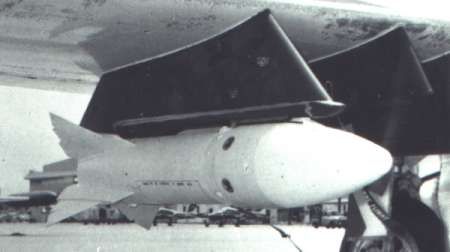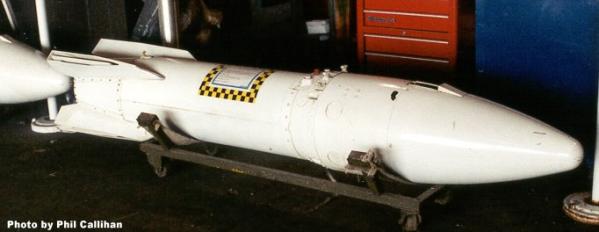Douglas MB-1/AIR-2 Genie
The Genie was the world's first nuclear-armed air-to-air weapon, and was the most powerful interceptor missile ever deployed by the USAF.
In 1954 Douglas started a study to determine the feasibility of a small nuclear-armed air-to-air missile. To keep the weapon as simple as possible, it was decided to develop an unguided rocket. Full-scale development started in 1955, and in early 1956 the first test firings were made by F-89D Scorpion aircraft. The then top-secret project had various code names, such as "Bird Dog", "Ding Dong", and "High Card", but ultimately the designation MB-1 and the name Genie was allocated. The MB-1 became operational in 1957, and on 19 July 1957 the first and only live firing of a nuclear Genie took place.
The MB-1 was powered by a Thiokol SR49 solid-fueled rocket motor, armed with a 1.5 kT nuclear warhead, and had flip-out fins for flight stability. The Genie was carried by F-89J, F-101B and F-106A interceptors. After launching the weapon, the firing aircraft had to pull away in a sharp turn to escape the blast, which was an especially demanding manoeuver for the subsonic F-89J. Warhead arming and detonation was triggered by a timer, which only began its countdown after successful ignition and subsequent burnout of the rocket motor. This was to prevent an accidental nuclear explosion over friendly territory should anything go wrong with the rocket. The Genie made a very effective weapon against high-flying bombers, because its short flight-time (< 12 s), immunity to countermeasures (their was no guidance system which could be fooled!), and high blast radius (about 300 m) made it virtually impossible for a bomber to avoid destruction.
 |
| Photo: USAF |
| MB-1 (AIR-2A) |
For training purposes there was a version designated MB-1-T "Ting-a-Ling" with a warhead which emitted a cloud of white smoke on detonation. There was also a projected improved version designated MMB-1 Super Genie, which was apparently not developed.
In June 1963, the Genie rockets were designated in the AIR-2 series, as follows:
| Old Designation | New Designation |
|---|---|
| MB-1 | AIR-2A |
| MB-1-T | ATR-2A |
| MMB-1 | AIR-2B |
There is some confusion about the designation of the training rocket. While ATR-2A seems to be the only officially assigned designation, a designation of ATR-2N is also frequently quoted.
 |
| Photo: Phil Callihan |
| AIR-2A |
Production of the Genie was terminated in 1962, after more than 1000 rockets had been built. In 1965, Thiokol began production of an improved motor for the AIR-2 with a longer life span and wider firing temperature limits. Production of this motor lasted until 1978. The designation AIR-2B was re-used for upgraded Genie rockets after the mid-1970s, and it's likely that this refers to rockets equipped with the improved motor. The last AIR-2 rockets were removed from the inventory in the early 1980s, when the last carrier aircraft, the F-106A, was finally withdrawn from service.
Specifications
Note: Data given by several sources show slight variations. Figures given below may therefore be inaccurate!
Data for AIR-2A:
| Length | 2.95 m (9 ft 8 in) |
| Finspan | 1.02 m (3 ft 4 in) (fins extended) |
| Diameter | 0.44 m (17.5 in) (body; warhead is larger) |
| Weight | 373 kg (822 lb) |
| Speed | Mach 3 |
| Range | 9.6 km (6 miles) |
| Propulsion | Thiokol SR49-TC-1 (model TU-289) solid-fueled rocket; 162 kN (36500 lb) |
| Warhead | W-25 nuclear fission (1.5 kT) |
Main Sources
[1] James N. Gibson: "Nuclear Weapons of the United States", Schiffer Publishing Ltd, 1996
[2] Bill Gunston: "The Illustrated Encyclopedia of Rockets and Missiles", Salamander Books Ltd, 1979
[3] Christopher Chant: "World Encyclopaedia of Modern Air Weapons", Patrick Stephens Ltd., 1988
Back to Current Designations Of U.S. Unmanned Military Aerospace Vehicles
Back to Directory of U.S. Military Rockets and Missiles
Last Updated: 16 January 2002